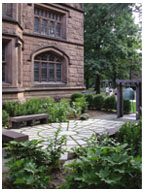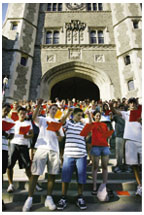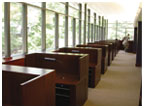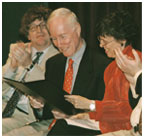October 8, 2003: Notebook
Princeton
dedicates memorial garden
Thirteen alumni remembered by family and friends
Dutch elm disease strikes hard

 Princeton
dedicates memorial garden
Princeton
dedicates memorial garden Thirteen alumni remembered by family and friends
Photo: One element in the memorial garden is a flagstone circle inlaid with 13 bronze stars bearing the names of alumni killed September 11. (Denise Applewhite)
In a moving ceremony marked by personal remembrances of lost loved ones, Princeton last month dedicated a memorial garden to honor the 13 alumni killed in the terrorist attacks of September 11, 2001.
“We have drawn on the solidity and strength of stone, wood, and bronze, and on the regenerative capacity of plant life, to communicate both permanence and continuous renewal,” President Tilghman said of the garden, between East Pyne Hall and Chancellor Green. “The garden is just off one of the most heavily used walkways . . . and yet it is sheltered in ways that provide comfort and encourage reflection.”
The serene space surrounds a large bluestone plaque and 13 bronze stars that are positioned in a circle and engraved with the names of the alumni. The plaque reads: “This garden is dedicated to the 13 Princeton alumni who tragically lost their lives in the terrorist attacks of September 11, 2001.”
Tilghman said that the garden’s principal architect, Jon Hlafter ’61 *63, Princeton’s director of physical planning, was inspired by the University’s use of stars to mark the dormitory rooms of alumni killed in military service, and by the circle of 13 stars in the first stars-and-stripes flag of the U.S.
The memorial is surrounded by plantings and three benches created from stone taken from inside East Pyne and Chancellor Green as they were being renovated. Flagstone in the memorial is cut from pieces that had been in walkways throughout the campus.
A bronze bell marks the entrance. The bell, named “Remembrance,” was designed by Toshiko Takaezu h’96, a ceramist, weaver, and painter who taught in Princeton’s visual arts program for about 25 years, retiring in 1992. At the dedication, Tilghman struck the bell 13 times, and it had a deep, resonant sound. Family members also were invited to strike the bell, and many did.
The ceremony, held under a tent to shelter participants from rain, was deeply personal. Donald Wiener remembered building model airplanes with his “son and best friend,” Jeffrey D. Wiener ’90. Randall S. Caswell, father of William E. Caswell *75, recalled his son’s scholarly achievements in physics, and how, in basketball, “he could really spike that ball.” Anthony Ingrassia, brother of Christopher N. Ingrassia ’95, spoke of how Christopher cherished his family and friends.
Other alumni killed September 11 were Robert L. Cruikshank ’58, Robert J. Deraney ’80, Karen J. Klitzman ’84, Catherine F. MacRae ’00, Charles A. McCrann ’68, Robert G. McIlvaine ’97, Christopher D. Mello ’98, Joshua A. Rosenthal *81, John T. Schroeder ’92, and Martin P. Wohlforth ’76.
“The family members and classmates here today, and the University
itself, put part of themselves into each of the alumni we honor in this
garden,” Tilghman said. “We remained intertwined for all time,
and this lovely garden ensures that this is something we shall never forget.”
![]() By M.M.
By M.M.
Editor’s note: Personal remembrances of the 13 alumni were published in our November 7, 2001 issue, and are available online, click here.

 Welcome,
Class of 2007
Welcome,
Class of 2007Freshman learning to sing “Old Nassau” on the steps of Blair Arch. The lesson took place after a special campus tour, sponsored by the Princetoniana Committee, to teach the young ones old tricks. (Frank Wojciechowski)
This year’s freshman class is one of the strongest academic classes in recent years. Dean of the College Nancy Malkiel reports that almost one-half of freshmen are academic 1’s, the highest rating given to applicants.
Financial aid recipients make up 52 percent of the class. In 2001, 38 percent of freshmen received aid.
Of the 1,171 freshmen, 13 percent are minority, 9 percent international,
and 12 percent legacy. Men make up 53 percent, women 47percent. One half
of the class was admitted early decision. This year’s yield was 73
percent. ![]()

So far this year the University has lost 12 American elm trees (Ulmus americana) to Dutch elm disease, and another six were treated and remain standing. “We usually lose two or three a year,” says Jim Consolloy, the University’s grounds manager, “but due to the unusually wet winter, spring, and early summer — which is an ideal growing environment for fungus — we had the worst outbreak in over 15 years.”
Of the 12 American elms lost, four were Princeton elms, which had been developed by Princeton Nurseries and had shown moderate resistance to Dutch elm disease over time. Two were in McCosh Courtyard, and two near 1879 Hall. The others were American Liberty elms, developed by the Elm Research Institute in New Hampshire as disease resistant, and were located throughout the campus.
“It’s a huge disappointment,” says Consolloy, “especially
after you spend so much time trying to grow a tree, and then to realize
it isn’t resistant.” Over the past decade, the University has
been planting beeches, sycamores, ashes, and London planes as well as
Chinese elms, which are resistant to Dutch elm disease. ![]()

 New
year, new spaces
New
year, new spaces
Photos: Light floods one of the new banks of carrels in the renovated Marquand library. (Denise Applewhite) Roger Berlind ’52 and McCarter artistic director Emily Mann, flanked by professor Paul Muldoon, far left, and professor Michael Cadden, at the dedication of the new theater. (Frank Wojciechowski)
This fall two venerable buildings are back in use after extensive renovations, and a new one has debuted.
The formerly dark and cramped Marquand Library of Art and Archaeology has reopened with all the up-to-date fixings, including a climate-controlled rare-book reading room and wireless data ports and Internet hookups at the study carrels and seminar tables. Colors such as Pompeii red and tree green brighten those walls not taken up by shelving or windows. With the installation of skylights and floor-to-ceiling windows, light now pours in.
 East
Pyne, home to most foreign languages, classics, and comparative literature,
has undergone such a transformation that it’s as if a new building
had materialized within its collegiate gothic skin. Excavations, wall
removals, and window-installations have made the structure cohesive at
last. The East Pyne renovation is part of a master plan to create a humanities
hub in the center of campus, which should be finished by June.
East
Pyne, home to most foreign languages, classics, and comparative literature,
has undergone such a transformation that it’s as if a new building
had materialized within its collegiate gothic skin. Excavations, wall
removals, and window-installations have made the structure cohesive at
last. The East Pyne renovation is part of a master plan to create a humanities
hub in the center of campus, which should be finished by June.
With the completion of the Roger S. Berlind Theatre, the University acquired more classroom and performance space for the Program in Theater and Dance, and the McCarter Theatre acquired a second stage. A joint project between the University and McCarter, the 360-seat theater was funded in part by impresario Roger Berlind ’52. The building was designed by architect Hugh Hardy ’54 *56, who has designed or renovated a number of theaters around the country.
A copy of the poem, “Lines
on Raising the Curtain of the Roger S. Berlind Theatre,” by Paul
Muldoon, which was read at the dedication, can be found at www.princeton.edu/
paw. ![]()

 In
Brief
In
Brief
Photo: The Class of 1948 Memorial Plaza was dedicated at ’48’s Feisty 55th.
The French Senate conferred the title of Commandeur de la Legion d’Honneur on Princeton professor emeritus André Maman because of his exemplary service to France. Maman joined the faculty in Romance Languages and Literatures in 1958. While a faculty member, Maman served as a representative of French citizens living abroad. He later was elected a French senator and retired from Princeton in 1993. Maman, who has completed his term as senator, remains active in promoting French culture throughout the world. He divides his time between Princeton and Paris.
The Class of 1948 Memorial Plaza was dedicated during Reunions 2003. Located next to West College, which houses the Office of Admissions, the flagstone plaza, once a drab gravel bed, is now part of the open space behind Nassau Hall. It’s benches offer potential applicants and their parents a pleasant place to gather during good weather. Attending the event were President Tilghman, class officers, and numerous 1948ers, who were on campus for their Feisty 55th reunion.
In addition to financial gifts to the University, major-reunion classes often add a service project to their festivities. This year the projects included 1963’s ongoing efforts with the National Academy Foundation, which helps inner-city kids get better secondary school educations; 1983’s participation in Habitat for Humanity, in Trenton; 1998’s help with the New Jersey Summer Special Olympics; and 1988’s contribution to the Newark Literacy Campaign, which works with young people, dropouts, single parents, and the unemployed. The class, which provided 100 books and $1,000, partnered with Amazon.com in the project.
Wu Jie, a Chinese student admitted to the Class of 2007, was denied
a visa four times this year by U.S. officials in Beijing because she did
not present a sufficiently convincing case that she would return to China
after completing her studies. University officials and alumni, notably
those in the Princeton Club of Beijing, have been working with Wu and
government officials to resolve the impasse. At this point, Wu has deferred
coming to Princeton for a year and is attending a university in Singapore.
![]()
